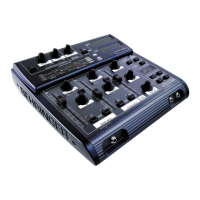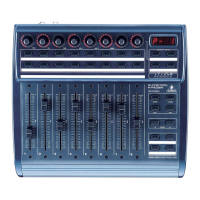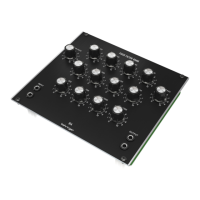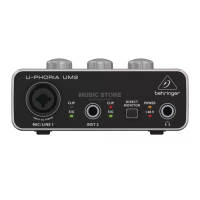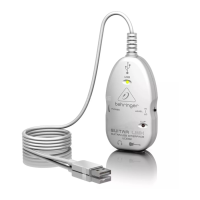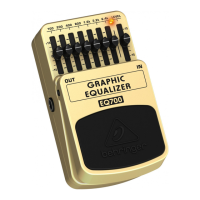11
B-CONTROL NANO BCN44
4. MIDI
3.3 Multiple MIDI controllers
Together with the BCN44, several MIDI controllers can be connected to one another in order to construct a
broad control setup. Your setup can be expanded with the members of our BEHRINGER B-CONTROL
series (BCR2000, BCF2000 and BCA2000).
Fig. 3.3: Combination with additional MIDI controllers
4. MIDI
Your B-CONTROL supports all kinds of MIDI messages, which are explained below:
Program Change Messages and MIDI Bank Select:
Program change commands are used to call up programs or presets on the MIDI devices connected to your
B-CONTROL. There are 128 program numbers available for calling up presets. For devices with more than
128 presets, you can use the Bank Select function, which lets you select a specific storage bank before
sending a program change message.
Control Change (CC):
Control Change Messages let you retrieve and automate many parameters and functions. You can allocate
individual control elements (controls, buttons etc.) on your B-CONTROL to CC messages. Because both
buttons and knobs can be used, you can control controller values either statically or dynamically, all in real
time.
+ Standard MIDI Control Change commands are listed in table 6.5 in the appendix (ch. 6).
NRPN:
Furthermore, you can also use controllers that feature no standard allocation, and can therefore be assigned
in many different ways. These are called NRPN (Non-Registered Parameter Numbers). NRPNs are broken
down to MSB (Most Significant Byte) and LSB (Least Significant Byte) in order to achieve a higher data
resolution. A low resolution becomes apparent very quickly, particularly during fader movements of a mixing
console. A resolution of 7 bit (= 128 values) makes for rough and bumpy level jumps. By dividing up the data
into MSBs and LSBs, you can accomplish 14-bit fader/encoder resolution, corresponding to a subdivision
into over 16.000 steps! In addition to NRPN, there are also RPN (Registered Parameter Numbers). RPN
commands are defined in the GM (General MIDI), GS (Roland
®
) and XG (Yamaha
®
) MIDI standards .

